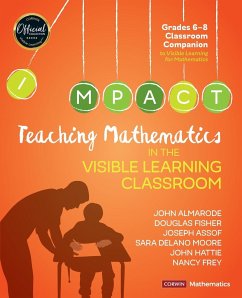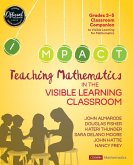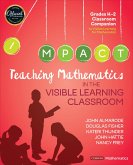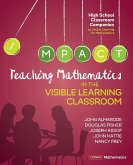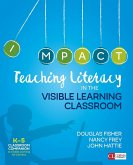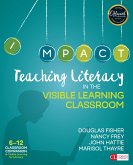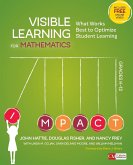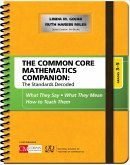John T. Almarode, Douglas Fisher, Joseph Assof
Teaching Mathematics in the Visible Learning Classroom, Grades 6-8
John T. Almarode, Douglas Fisher, Joseph Assof
Teaching Mathematics in the Visible Learning Classroom, Grades 6-8
- Broschiertes Buch
- Merkliste
- Auf die Merkliste
- Bewerten Bewerten
- Teilen
- Produkt teilen
- Produkterinnerung
- Produkterinnerung
This book helps teachers leverage the most effective teaching practices at the most effective time to meet the surface, deep, and transfer learning needs of mathematics students.
Andere Kunden interessierten sich auch für
![Teaching Mathematics in the Visible Learning Classroom, Grades 3-5 Teaching Mathematics in the Visible Learning Classroom, Grades 3-5]() John T. Almarode (USA James Madison University)Teaching Mathematics in the Visible Learning Classroom, Grades 3-536,99 €
John T. Almarode (USA James Madison University)Teaching Mathematics in the Visible Learning Classroom, Grades 3-536,99 €![Teaching Mathematics in the Visible Learning Classroom, Grades K-2 Teaching Mathematics in the Visible Learning Classroom, Grades K-2]() John T. Almarode (USA James Madison University)Teaching Mathematics in the Visible Learning Classroom, Grades K-238,99 €
John T. Almarode (USA James Madison University)Teaching Mathematics in the Visible Learning Classroom, Grades K-238,99 €![Teaching Mathematics in the Visible Learning Classroom, High School Teaching Mathematics in the Visible Learning Classroom, High School]() John T. AlmarodeTeaching Mathematics in the Visible Learning Classroom, High School37,99 €
John T. AlmarodeTeaching Mathematics in the Visible Learning Classroom, High School37,99 €![Teaching Literacy in the Visible Learning Classroom, Grades K-5 Teaching Literacy in the Visible Learning Classroom, Grades K-5]() Douglas FisherTeaching Literacy in the Visible Learning Classroom, Grades K-537,99 €
Douglas FisherTeaching Literacy in the Visible Learning Classroom, Grades K-537,99 €![Teaching Literacy in the Visible Learning Classroom, Grades 6-12 Teaching Literacy in the Visible Learning Classroom, Grades 6-12]() Douglas FisherTeaching Literacy in the Visible Learning Classroom, Grades 6-1248,99 €
Douglas FisherTeaching Literacy in the Visible Learning Classroom, Grades 6-1248,99 €![Visible Learning for Mathematics, Grades K-12 Visible Learning for Mathematics, Grades K-12]() John HattieVisible Learning for Mathematics, Grades K-1240,99 €
John HattieVisible Learning for Mathematics, Grades K-1240,99 €![The Common Core Mathematics Companion: The Standards Decoded, Grades 3-5 The Common Core Mathematics Companion: The Standards Decoded, Grades 3-5]() Linda M. GojakThe Common Core Mathematics Companion: The Standards Decoded, Grades 3-539,99 €
Linda M. GojakThe Common Core Mathematics Companion: The Standards Decoded, Grades 3-539,99 €-
-
-
This book helps teachers leverage the most effective teaching practices at the most effective time to meet the surface, deep, and transfer learning needs of mathematics students.
Produktdetails
- Produktdetails
- Corwin Mathematics Series
- Verlag: SAGE Publications Inc
- Seitenzahl: 266
- Erscheinungstermin: 8. November 2018
- Englisch
- Abmessung: 235mm x 191mm x 14mm
- Gewicht: 524g
- ISBN-13: 9781544333182
- ISBN-10: 1544333188
- Artikelnr.: 53482870
- Herstellerkennzeichnung
- Libri GmbH
- Europaallee 1
- 36244 Bad Hersfeld
- gpsr@libri.de
- Corwin Mathematics Series
- Verlag: SAGE Publications Inc
- Seitenzahl: 266
- Erscheinungstermin: 8. November 2018
- Englisch
- Abmessung: 235mm x 191mm x 14mm
- Gewicht: 524g
- ISBN-13: 9781544333182
- ISBN-10: 1544333188
- Artikelnr.: 53482870
- Herstellerkennzeichnung
- Libri GmbH
- Europaallee 1
- 36244 Bad Hersfeld
- gpsr@libri.de
Dr. John Almarode is a bestselling author and an Associate Professor of Education at James Madison University. He was awarded the inaugural Sarah Miller Luck Endowed Professorship in 2015 and received an Outstanding Faculty Award from the State Council for Higher Education in Virginia in 2021. Before his academic career, John started as a mathematics and science teacher in Augusta County, Virginia. As an author, John has written multiple educational books focusing on science and mathematics, and he has co-created a new framework for developing, implementing, and sustaining professional learning communities called PLC+. Dr. Almarode¿s work has been presented to the US Congress, the Virginia Senate, and the US Department of Education. John and his colleagues have also focused a lot of attention on the process of implementation - taking evidence-based practices and moving them from intention to implementation, potential to impact through a series of on-your-feet-guides around PLCs, Visible Learning, Visible Teaching, and the SOLO Taxonomy.
List of Videos
Acknowledgments
About the Authors
Introduction
What Works Best
What Works Best When
The Path to Assessment-Capable Visible Learners in Mathematics
How This Book Works
Chapter 1. Teaching With Clarity in Mathematics
Components of Effective Mathematics Learning
Surface, Deep, and Transfer Learning
Moving Learners Through the Phases of Learning
Differentiating Tasks for Complexity and Difficulty
Checks for Understanding
Profiles of Three Teachers
Reflection
Chapter 2. Teaching for the Application of Concepts and Thinking Skills
Ms. Halstrom and Circles and Cylinders
Ms. Fernandez and Systems of Linear Equations
Mr. Singh and Integers
Reflection
Chapter 3. Teaching for Conceptual Understanding
Ms. Halstrom and Circles and Cylinders
Ms. Fernandez and Systems of Linear Equations
Mr. Singh and Integers
Reflection
Chapter 4. Teaching for Procedural Knowledge and Fluency
Ms. Halstrom and Circles and Cylinders
Ms. Fernandez and Systems of Linear Equations
Mr. Singh and Integers
Reflection
Chapter 5. Knowing Your Impact: Evaluating for Mastery
What Is Mastery Learning?
Ensuring Tasks Evaluate Mastery
Ensuring Tests Evaluate Mastery
Feedback for Mastery
Conclusion
Final Reflection
Appendices
A. Effect Sizes
B. Teaching for Clarity Planning Guide
C. Learning Intentions and Success Criteria Template
D. A Selection of International Mathematical Practice or Process Standards
References
Index
Acknowledgments
About the Authors
Introduction
What Works Best
What Works Best When
The Path to Assessment-Capable Visible Learners in Mathematics
How This Book Works
Chapter 1. Teaching With Clarity in Mathematics
Components of Effective Mathematics Learning
Surface, Deep, and Transfer Learning
Moving Learners Through the Phases of Learning
Differentiating Tasks for Complexity and Difficulty
Checks for Understanding
Profiles of Three Teachers
Reflection
Chapter 2. Teaching for the Application of Concepts and Thinking Skills
Ms. Halstrom and Circles and Cylinders
Ms. Fernandez and Systems of Linear Equations
Mr. Singh and Integers
Reflection
Chapter 3. Teaching for Conceptual Understanding
Ms. Halstrom and Circles and Cylinders
Ms. Fernandez and Systems of Linear Equations
Mr. Singh and Integers
Reflection
Chapter 4. Teaching for Procedural Knowledge and Fluency
Ms. Halstrom and Circles and Cylinders
Ms. Fernandez and Systems of Linear Equations
Mr. Singh and Integers
Reflection
Chapter 5. Knowing Your Impact: Evaluating for Mastery
What Is Mastery Learning?
Ensuring Tasks Evaluate Mastery
Ensuring Tests Evaluate Mastery
Feedback for Mastery
Conclusion
Final Reflection
Appendices
A. Effect Sizes
B. Teaching for Clarity Planning Guide
C. Learning Intentions and Success Criteria Template
D. A Selection of International Mathematical Practice or Process Standards
References
Index
List of Videos
Acknowledgments
About the Authors
Introduction
What Works Best
What Works Best When
The Path to Assessment-Capable Visible Learners in Mathematics
How This Book Works
Chapter 1. Teaching With Clarity in Mathematics
Components of Effective Mathematics Learning
Surface, Deep, and Transfer Learning
Moving Learners Through the Phases of Learning
Differentiating Tasks for Complexity and Difficulty
Checks for Understanding
Profiles of Three Teachers
Reflection
Chapter 2. Teaching for the Application of Concepts and Thinking Skills
Ms. Halstrom and Circles and Cylinders
Ms. Fernandez and Systems of Linear Equations
Mr. Singh and Integers
Reflection
Chapter 3. Teaching for Conceptual Understanding
Ms. Halstrom and Circles and Cylinders
Ms. Fernandez and Systems of Linear Equations
Mr. Singh and Integers
Reflection
Chapter 4. Teaching for Procedural Knowledge and Fluency
Ms. Halstrom and Circles and Cylinders
Ms. Fernandez and Systems of Linear Equations
Mr. Singh and Integers
Reflection
Chapter 5. Knowing Your Impact: Evaluating for Mastery
What Is Mastery Learning?
Ensuring Tasks Evaluate Mastery
Ensuring Tests Evaluate Mastery
Feedback for Mastery
Conclusion
Final Reflection
Appendices
A. Effect Sizes
B. Teaching for Clarity Planning Guide
C. Learning Intentions and Success Criteria Template
D. A Selection of International Mathematical Practice or Process Standards
References
Index
Acknowledgments
About the Authors
Introduction
What Works Best
What Works Best When
The Path to Assessment-Capable Visible Learners in Mathematics
How This Book Works
Chapter 1. Teaching With Clarity in Mathematics
Components of Effective Mathematics Learning
Surface, Deep, and Transfer Learning
Moving Learners Through the Phases of Learning
Differentiating Tasks for Complexity and Difficulty
Checks for Understanding
Profiles of Three Teachers
Reflection
Chapter 2. Teaching for the Application of Concepts and Thinking Skills
Ms. Halstrom and Circles and Cylinders
Ms. Fernandez and Systems of Linear Equations
Mr. Singh and Integers
Reflection
Chapter 3. Teaching for Conceptual Understanding
Ms. Halstrom and Circles and Cylinders
Ms. Fernandez and Systems of Linear Equations
Mr. Singh and Integers
Reflection
Chapter 4. Teaching for Procedural Knowledge and Fluency
Ms. Halstrom and Circles and Cylinders
Ms. Fernandez and Systems of Linear Equations
Mr. Singh and Integers
Reflection
Chapter 5. Knowing Your Impact: Evaluating for Mastery
What Is Mastery Learning?
Ensuring Tasks Evaluate Mastery
Ensuring Tests Evaluate Mastery
Feedback for Mastery
Conclusion
Final Reflection
Appendices
A. Effect Sizes
B. Teaching for Clarity Planning Guide
C. Learning Intentions and Success Criteria Template
D. A Selection of International Mathematical Practice or Process Standards
References
Index

